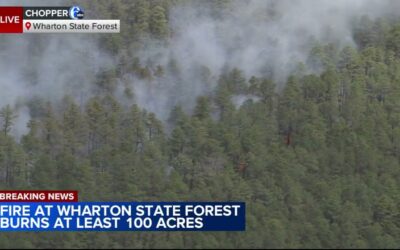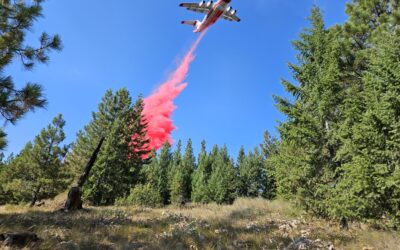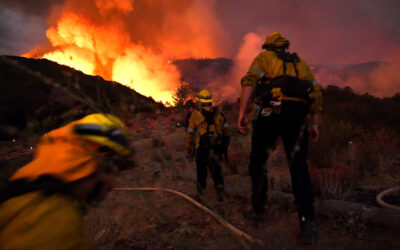By Chad Costa
California is a fantastic place to live. As an avid outdoors person and someone who enjoys time away from city life, California is an excellent fit. Northern California is filled with massive redwoods and beautiful communities tucked away in the mountains. Eastern California is aligned with the fantastic Sierra Nevada Mountain range. Southern California provides the ideal climate, and Western California offers beautiful beaches along the Pacific Ocean.
Unfortunately, some negatives come with living in the beautiful State of California. Due to the geographical location of California, we are sandwiched between the Nevada desert and the Pacific Ocean, with mountain ranges like the Sierras, San Gabriels, and San Ynez in between. California is subject to significant wind events as the air travels from high to low pressures and wind patterns created by the excessive heat to the East and the cool Pacific Ocean air to the West. With the combination of fuels, wind, and topography, California is prime territory for massive wildfires. In addition, drought has persisted for multiple years, adding to the wildfire threat and overall size and spread of our wildfires. Combining these factors has resulted in explosive wildfires, ravaging communities and destroying much of our forest land.
Fuel
Including the beautiful mountains, lakes, and ocean, California is also known for its abundance of tree species. From the Giant Sequoias, beautiful Coastal Redwoods, towering Pines, Cedars, and Fir trees. Unfortunately, due to the drought and bark beetle attacks, California has millions of drought-stricken trees and dead standing or down trees. These drought-stricken or dead/dying trees only add to our wildfires’ size, speed, and complexity. In addition, California, especially Southern California, is known for its abundance of highly flammable scrubs like Chamise, Manzanita, and Sage Brush. Our mountains are full of brush, and our communities embedded in these trees and brush have and will continue to be at risk. The US Forest Service, Cal Fire, Native Tribes, and Local and County Governments have taken an aggressive approach to hazard mitigation and fuel reduction around these communities. But it will take years and continue to be an ongoing process to try and get ahead of our challenges.
Winds
Sundowner winds are the northerly offshore wind that occurs along the southern Pacific slope of the Santa Ynez Mountains in communities along the Gaviota Coast and Santa Barbara. Sundowners are particularly dangerous during wildfire season because the air heats and dries as it descends from the mountains to the sea. Gale-force hot and dry winds can make firefighting impossible. Santa Ana winds in Southern California are strong, arid downslope winds originating inland and affecting coastal Southern California and northern Baja California. They originate from cool, dry high-pressure air masses in the Great Basin. These low humidities, warm,
Compressional-heated air mass, and high wind speeds create critical fire weather conditions and fan destructive wildfires. Over Central/Northern California, dry offshore winds are known as “Diablo” or north winds and are close cousins to the Santa Ana winds of Southern California. These winds are most frequent during the fall and early winter when high pressure builds inland over the Intermountain West, producing an offshore pressure gradient and dry low-level flow with an easterly component. Diablo wind events possess many characteristics of a terrain-induced downslope windstorm and are generally most substantial at night.
Topography
California has over 350 mountain ranges with almost 1,800 named peaks. The most significant and famous range is the Sierra Nevada, which has the highest mountain in the lower 48 US States, Mount Whitney, and Yosemite National Park. The Coast Range runs along the west side of the state, while the Cascade Range and the Klamath Mountains are in the North. Other ranges include the Inyo, San Bernadino, San Ynez, and the California Coastal Range. These ranges add up to 33 million acres of forest, where federal agencies (including the USDA Forest Service and USDI Bureau of Land Management and the National Park Service) own and manage 19 million acres. The rest include state-responsible land, where CalFire is responsible, and public land, where cities, counties, and special districts manage the lands. These complexities, which have millions of acres of massive peaks and mountain ranges, add to the complexity of wildfires in California. All agencies must work together across boundary lines as these fires can’t be managed alone. It’s an all-hands-on-deck situation with this new normal.
Putting it all Together
Modern wildland firefighters face new challenges with fuel, wind, topography, and sometimes drought. Recent fires have grown at an unprecedented rate, where modern firefighting tactics are many times fruitless. Firefighters have found themselves in situations where fighting the fire is not an option. The only option is to save their lives and as many civilians’ lives as possible.
When faced with a rapidly growing wildfire, firefighters are often put in situations where they must prioritize what they will attempt to save. They are put into these situations due to the overwhelming size of these fires and the impossible task of mustering enough firefighting resources to try and protect everything. A risk analysis is a consistently reevaluated process that allows firefighting leadership to identify the priorities that will be addressed with the available firefighting forces. The growth and heat of these fires require an immediate focus on human lives. However, when the fire moderates and/or civilians are evacuated, we can focus on our second and third priorities (property and the environment).
Although structures can be rebuilt, it’s our second priority to save as much property as possible. When prioritizing property, firefighters generally prioritize essential infrastructure in a community. Top priorities include schools, grocery stores, supply stores, places of worship, libraries, police/fire stations, and other critical community structures. This doesn’t mean that other structures are not a priority. Firefighters can often save homes and other buildings that may not be stated above. This risk analysis helps determine where your forces will be deployed. When the risk analysis tells leadership that the fire is too massive, growing too fast, and/or there are not enough firefighters to protect all structures, then that is where we pivot to a priority-based thought process, where we consider the importance of the building to the resiliency of the community post-fire. The community’s resiliency after the fire will increase if we save vital infrastructure.
Our third priority is the environment. Amongst 33 million acres of forest land and an additional 15 million acres of public land, California has a plethora of environmental considerations when threatened by wildfire. Our Giant Sequoias, Coastal Redwoods, Archaeological Sites, Watersheds, and overall ecosystem are massive considerations when determining tactics and strategies in fighting wildfire. We must do everything possible to preserve natural resources as our climate, water, and historical value depend on it. Although lives are number one, and always will be, other priorities mean a lot to the history and future of our habit in California.
Bio: Chad Costa, (BS-CFO) CalFire IMT 1
Assistant Fire Chief
City of Petaluma | Fire




